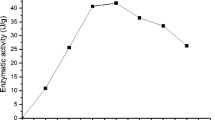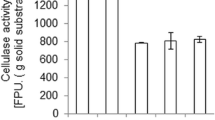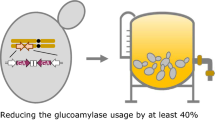Abstract
In this study, corn starch was used as the substrate for cell growth and trehalose accumulation by Saccharomycopsis fibuligera A11. Effect of different aeration rates, agitation speeds, and concentrations of corn starch on direct conversion of corn starch to trehalose by S. fibuligera A11 were examined using a Biostat B2 2-l fermentor. We found that the optimal conditions for direct conversion of corn starch to trehalose by this yeast strain were that agitation speed was 200 rpm, aeration rate was 4.0 l/min, concentration of corn starch was 2.0% (w/v), initial pH was 5.5, fermentation temperature was 30°C. Under these conditions, over 22.9 g of trehalose per 100 g of cell dry weight was accumulated in the yeast cells, cell mass was 15.2 g/l of the fermentation medium, 0.12% (w/v) of reducing sugar, and 0.21% (w/v) of total sugar were left in the fermented medium within 48 h of the fermentation. It was found that trehalose in the yeast cells could be efficiently extracted by the hot distilled water (80°C). After isolation and purification, the crystal trehalose was obtained from the extract of the cells.








Similar content being viewed by others
References
Aranda JS, Salgado E, Taillandier P (2004) Trehalose accumulation in Saccharomyces cerevisiae cells: experimental data and structured modeling. Biochem Eng J 17:129–140
Cardoso FS, Gaspar P, Hugenholtz J, Ramos A, Helena Santos H (2004) Enhancement of trehalose production in dairy propionibacteria through manipulation of environmental conditions. Int J Food Microbiol 91:195–204
Chen L, Chi ZM, Chi Z, Li M (2009) Amylase production by Saccharomycopsis fibuligera A11 in solid-state fermentation for hydrolysis of cassava starch. Appl Biochem Biotechnol. doi: 10.1007/s12010-009-8744-3
Chi ZM, Liu J, Zhang W (2001) Trehalose accumulation from soluble starch by Saccharomycopsis fibuligera sdu. Enzyme Microb Technol 38:240–246
Chi ZM, Liu J, Ji JR, Meng ZL (2003) Enhanced conversion of soluble starch to trehalose by a mutant of Saccharomycopsis fibuligera sdu. J Biotechnol 102:135–141
Chi ZM, Zhao SZ (2003) Optimization of medium and cultivation conditions for pullulan production by a new pullulan-producing yeast strain. Enzyme Microb Technol 33:206–211
Chi ZM, Chi Z, Liu GL, Wang F, Ju L, Zhang T (2009) Saccharomycopsis fibuligera and its applications in biotechnology. Biotechnol Adv 27:423–431
Cho YJ, Park OJ, Shin HJ (2006) Immobilization of thermostable trehalose synthase for the production of trehalose. Enzyme Microb Technol 39:108–113
Deegenaars MI, Kenneth Watson K (1998) Heat shock response in psychrophilic and psychrotrophic yeast from Antarctica. Extremophiles 2:41–49
Duan XH, Chi ZM, Wang L, Wang XH (2008) Influence of different sugars on pullulan production and activities of α-phosphoglucose mutase, UDPG-pyrophosphorylase and glucosyltransferase involved in pullulan synthesis in Aureobasidium pullulans Y68. Carbohydr Polym 73:587–593
Futatsugi M, Ogawa T, Fukuda H (1993) Purification and properties of two forms of glucoamylase from Saccharomycopsis fibuligera. J Ferment Bioeng 76:521–523
Gao J, Chi ZM (2001) Relationship between trehalose content and ethanol tolerance in high ethanol tolerant yeast and ethanol sensitive yeast. Food Ferment Ind 27:4–7
Hostinova V, Solovicov A, Dvorsky R, Gasperik J (2003) Molecular cloning and 3D structure prediction of the first raw-starch-degrading glucoamylase without a separate starch-binding domain. Arch Biochem Biophys 411:189–195
Jepsen HF, Jensen B (2004) Accumulation of trehalose in the thermophilic fungus Chaetomium thermophilum var. coprophilum in response to heat or salt stress. Soil Biol Biochem 36:1669–1674
Knox AM, du Preez JC, Kilian SG (2004) Starch fermentation characteristics of Saccharomyces cerevisiae strains transformed with amylase genes from Lipomyces kononenkoae and Saccharomycopsis fibuligera. Enzyme Microb Technol 34:453–460
Kobayashi K, Komeda T, Miura Y, Kettoku M, Kato M (1997) Production of trehalose from starch by novel trehalose-producing enzymes from Sulfolobus solfataricus KM1. J Ferment Eng 83:296–298
Kurtzman CP, Fell JW (eds) (2000) The yeasts. A taxonomic study, 4th revised and enlarged edn. Elsevier, Amsterdam, pp 377–378
Lernia ID, Schiraldi C, Generoso M, Rosa MD (2002) Trehalose production at high temperature exploiting an immobilized cell bioreactor. Extremophiles 6:341–347
Miyazaki JI, Miyagawa KI, Sugiyama Y (1996) Trehalose accumulation by a basidiomycotious yeast, Filobasidium floriforme. J Ferment Bioeng 4:315–319
Mukai K, Tabuchi A, Nakada T, Shibuya T, Chaen H, Fukuda S, Kurimoto M, Tsujisaka Y (1997) Production of trehalose from starch by thermostable enzymes from Sulfolobus acidocaldarius. Starch 49:26–30
Plourde-Owobi L, Durner S, Goma G, Francois J (2000) Trehalose reserves in Saccharomyces cerevisiae: phenomenon of transport, accumulation and role in cell viability. Int J Food Microbiol 55:33–40
Satto K, Kase T, Takahashi E, Takahashi E, Horinouchi S (1998) Purification and characterization of a trehalose synthase from the basidiomycete Grifola frondosa. Appl Environ Microbiol 64:4340–4345
Schick I, Haltrich D, Kulbe KD (1995) Trehalose phosphorylase from Pichia fermentans and its role in the metabolism of trehalose. Appl Microbiol Biotechnol 43:1088–1095
Spiro RG (1966) Analysis of sugars found in glycoproteins. Methods Enzymol 8:3–26
Stewart PR (1982) Trehalose extraction and determination. In: Prescott DM (ed) Methods in cell biology, vol 12. Academic Press, London, pp 111–147
Yoshida M, Shizuoka NN, Saitama KH (1997) Production of trehalose from starch by maltose phosphorylase and trehalose phosphorylase from a strain of Plesiomonas. Starch 49:21–26
Acknowledgments
The authors would like to thanks Qingdao Municipal Science and Technology Commission, Qingdao, China for providing financial support to carry out this work. The grant no. is 06-2-2-22-jch.
Author information
Authors and Affiliations
Corresponding author
Rights and permissions
About this article
Cite this article
Chi, Z., Wang, JM., Chi, ZM. et al. Trehalose accumulation from corn starch by Saccharomycopsis fibuligera A11 during 2-l fermentation and trehalose purification. J Ind Microbiol Biotechnol 37, 19–25 (2010). https://doi.org/10.1007/s10295-009-0644-6
Received:
Accepted:
Published:
Issue Date:
DOI: https://doi.org/10.1007/s10295-009-0644-6




